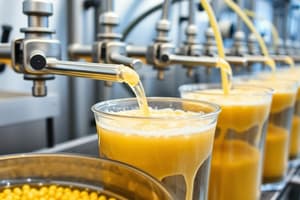Podcast
Questions and Answers
Which microorganism is used for the production of high yields of vitamin B12?
Which microorganism is used for the production of high yields of vitamin B12?
- Thiobacillus ferrooxidans
- Clostridium acetobutylicum
- Propionibacterium (correct)
- Thermus aquaticus
What byproducts can be produced using Clostridium acetobutylicum?
What byproducts can be produced using Clostridium acetobutylicum?
- Copper sulphate
- Methane and carbon dioxide
- Acetone and butanol (correct)
- Insulin
Which process is Thiobacillus ferrooxidans involved in?
Which process is Thiobacillus ferrooxidans involved in?
- Petroleum biodegradation
- Oxidation of copper ores to copper sulphate (correct)
- Production of cortisone
- Genetic engineering of insulin
Which enzyme derived from Thermus aquaticus is crucial for PCR?
Which enzyme derived from Thermus aquaticus is crucial for PCR?
Which method is NOT used for sewage and wastewater treatment?
Which method is NOT used for sewage and wastewater treatment?
What is an application of genetic engineering as mentioned in the content?
What is an application of genetic engineering as mentioned in the content?
Which microorganism is used in the production of citric acid?
Which microorganism is used in the production of citric acid?
What significant change occurred regarding causes of death from 1900 to now?
What significant change occurred regarding causes of death from 1900 to now?
What is the role of bacteria in the nodules of legume roots?
What is the role of bacteria in the nodules of legume roots?
Which bacteria are involved in the digestion of cellulose in ruminants?
Which bacteria are involved in the digestion of cellulose in ruminants?
Which of the following is a product of the fermentation by Propionibacteria in the food industry?
Which of the following is a product of the fermentation by Propionibacteria in the food industry?
Which harmful effect is associated with overuse of antibiotics?
Which harmful effect is associated with overuse of antibiotics?
In which process does Acetobacter oxidize sorbitol to produce sorbose?
In which process does Acetobacter oxidize sorbitol to produce sorbose?
Which type of bacteria is used in probiotic yoghurts and drinks?
Which type of bacteria is used in probiotic yoghurts and drinks?
What is the primary function of saprophytic bacteria in the soil?
What is the primary function of saprophytic bacteria in the soil?
What is the role of Bacillus licheniformis in biological washing powders?
What is the role of Bacillus licheniformis in biological washing powders?
Flashcards are hidden until you start studying
Study Notes
Pharmaceutical and Chemical Industry
- Cortisone and hydrocortisone are produced with the help of fungus Rhizopus nigricans, which carries out stereospecific hydroxylation of a cortisone precursor.
- Vitamins and amino acids, such as vitamin B12, are produced using microorganisms like Propionibacterium.
- Acetone and butanol can be produced through fermentation processes involving Clostridium acetobutylicum.
Environmental
- Sewage and waste water treatment involve anaerobic and aerobic methods.
- Microorganisms can degrade hydrocarbons in petroleum, which can be detrimental if it occurs in tanks with water and air present.
- Bioremediation of oil spillages is a positive use of microorganisms.
Environmental
- Methane is produced by methanogenic bacteria, which has led to the development of biofuels.
- Microbial leaching of ores is a process that involves the oxidation of copper ores to soluble copper sulphate by acidophilic bacteria like Thiobacillus ferrooxidans.
- Many metals, such as copper, form insoluble sulphides.
Biotechnology
- Genetic engineering enables gene manipulation and the production of artificial gene products like insulin.
- Human insulin gene is engineered into a microorganism to produce recombinant vaccines.
- The thermostable DNA polymerase of Thermus aquaticus, known as Taq polymerase, has enabled more effective PCR.
Impact of Microorganisms on Humans
- Microorganisms have vastly increased the benefits to humans and minimized the damage they cause.
- Relatively few microorganisms cause disease to humans.
- In 1900, infection was the major cause of death, but statistics have changed since then.
Agriculture
- Legumes and nodules on roots contain bacteria that fix nitrogen, forming part of the nitrogen cycle.
- This reduces the need for fertilizers and is a symbiotic relationship.
- Bacteria in the digestive process of ruminants, such as ruminococci, digest cellulose in a symbiotic relationship.
Food Industry
- Lactic acid is produced by bacteria in dairy products, metabolizing lactose in milk.
- Butter is produced by adding lactic acid starter cultures to cream, which involves bacteria like Lactococcus cremoris or L.lactis.
- Cheese is produced by coagulating and fermenting milk, and adding other bacteria, such as Propionibacteria in Swiss cheese or Penicillium sp. in blue cheese.
- Vinegar is produced by fermenting ethyl alcohol to acetic acid using genera like Acetobacter or Gluconobacter.
- Citric acid is produced by fermenting using Aspergillus niger.
- Yeasts are used in edible fungi, alcoholic drinks, and baked goods.
Beneficial Uses of Microorganisms
- Saprophytic bacteria in the soil convert complex molecules into forms accessible to plants, taking part in the carbon, nitrogen, and sulphur cycles.
- Silage making involves fermenting hay anaerobically using Lactobacillus sp.
- Yoghurt is produced by fermenting low-fat milk with Lactobacillus bulgaricus and Streptococcus bulgaricus.
- Probiotic yoghurts and drinks are also produced using microorganisms.
- Monosodium glutamate is produced from L-glutamic acid from Corynebacteria glutamicum grown aerobically on molasses.
- Bacteria are also used in coffee and cocoa preparation.
- Antibiotics are produced by large-scale fermentation processes involving filamentous fungi and bacteria of the Actinomycete group.
- Biological washing powders contain enzymes called subtilisins produced by Bacillus licheniformis, which hydrolyze most types of protein bonds, are pH stable, and non-Ca2+ dependant.
Studying That Suits You
Use AI to generate personalized quizzes and flashcards to suit your learning preferences.




